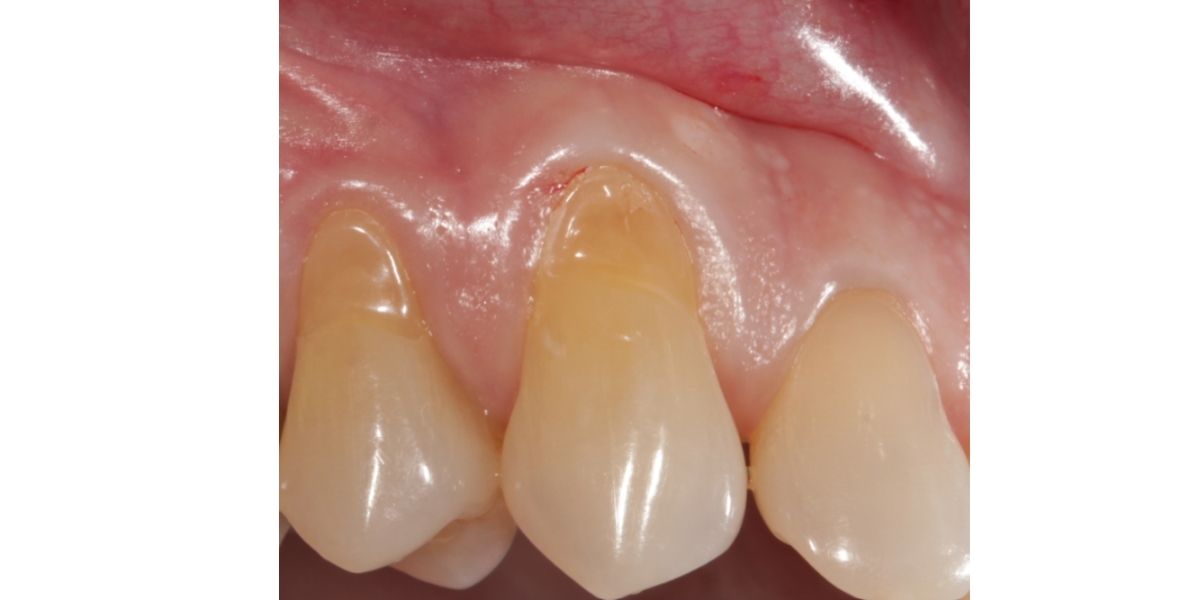Wearing away of a tooth. It may be caused by incorrect tooth brushing (The point where the tooth meets the gum is particularly vulnerable as the root may have become exposed). It can be made worse by the use of abrasive toothpaste (e.g. smokers). Any damage near the gum may be extremely sensitive and need treatment from a dentist. Applying sensitive toothpastes may be an effective remedy.

Abrasion is the non-carious, mechanical wear of tooth from interaction with objects other than tooth-tooth contact. It most commonly affects the premolars and canines, usually along the cervical margins. Based on clinical surveys, studies have shown that abrasion is the most common but not the sole aetiological factor for development of non-carious cervical lesions (NCCL) and is most frequently caused by incorrect toothbrushing technique.
Abrasion frequently presents at the cemento-enamel junction and can be caused by many contributing factors, all with the ability to affect the tooth surface in varying degrees.
The appearance may vary depending on the cause of abrasion, however most commonly presents in a V-shaped caused by excessive lateral pressure whilst tooth-brushing. The surface is shiny rather than carious, and sometimes the ridge is deep enough to see the pulp chamber within the tooth itself.
Non-carious cervical loss due to abrasion may lead to consequences and symptoms such as increased tooth sensitivity to hot and cold, increased plaque trapping which will result in caries and periodontal disease, and difficulty of dental appliances such as retainers or dentures engaging the tooth. It may also be aesthetically unpleasant to some people.
For successful treatment of abrasion, the cause first needs to be identified and ceased (e.g. overzealous brushing). Once this has occurred, subsequent treatment may involve the changes in oral hygiene, application of fluoride to reduce sensitivity, or the placement of a restoration to help prevent further loss of tooth structure and aid plaque control.
Cause
Abrasion occurring on the cervical margins from the effects of friction from toothbrushing and abrasive toothpastes.
Cause of abrasion may arise from interaction of teeth with other objects such as toothbrushes, toothpicks, floss, and ill-fitting dental appliance like retainers and dentures. Apart from that, people with habits such as nail biting, chewing tobacco, lip or tongue piercing, and having occupation such as joiner, are subjected to higher risks of abrasion.
The aetiology of dental abrasion can be due to a single stimulus or, as in most cases, multi-factorial. The most common cause of dental abrasion is the combination of mechanical and chemical wear.
Tooth brushing is the most common cause of dental abrasion, which is found to develop along the gingival margin, due to vigorous brushing in this area. The type of toothbrush, the technique used and the force applied when brushing can influence the occurrence and severity of resulting abrasion. Further, brushing for extended periods of time (exceeding 2-3 min) in some cases, when combined with medium/hard bristled toothbrushes can cause abrasive lesions. Abrasion may also be exacerbated by overzealous use of certain types of dentifrice; some have more abrasive qualities to remove stains such as whitening toothpastes.
The bristles combined with forceful brushing techniques applied can roughen the tooth surface and cause abrasion as well as aggravating the gums. Repetitive irritation to the gingival margin can eventually cause recession of the gums. When the gums recede, the root surface is exposed which is more susceptible to abrasion. Comparatively, electric toothbrushes have less abrasive tendencies.
When combined with incorrect brushing technique, toothpastes can also damage enamel and dentine due to the abrasive properties. Specific ingredients are used in toothpaste to target removal of the bio-film and extrinsic staining however in some cases can contribute to the pastes being abrasive. In-home and clinical whitening have been proven to increase the likelihood of an individual experiencing dental abrasion. It is believed that dental abrasion due to the whitening process is caused by a combination of both mechanical and chemical irritants, for example, using whitening toothpaste and at home bleaching kits together. However, if an individual is regimented in their after-whitening care then they can avoid loss of tooth structure and in turn abrasion can be avoided.
Forest & Ray is a private dentist in London (Holborn, Camden) offering a wide range of treatments (basically everything), same-day appointments 7 days a week and affordable prices. The key behind a beautiful smile is self confidence, and success. At Forest & Ray we ensure to help you to the best of our ability. If you place your trust in us, we will make sure you achieve your goals and maintain oral hygiene to the maximum of its capacity. Regardless of any age or condition, we promise painless treatments and a professional team.